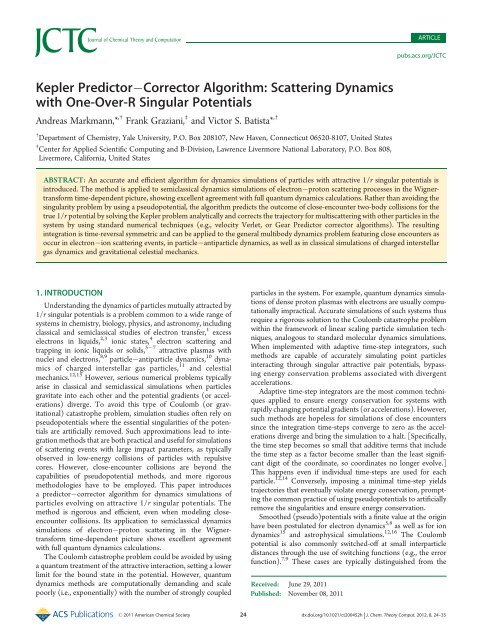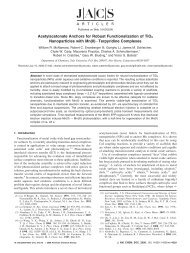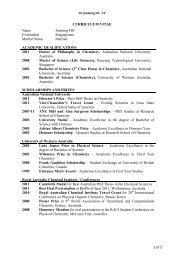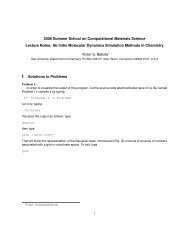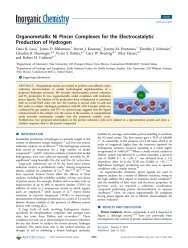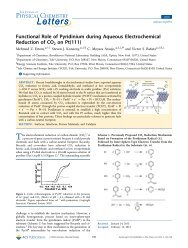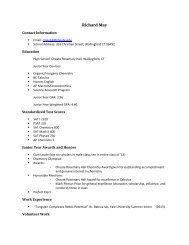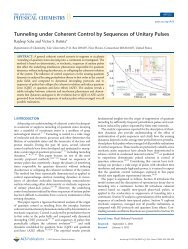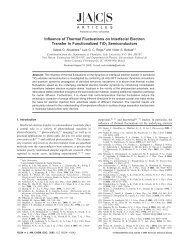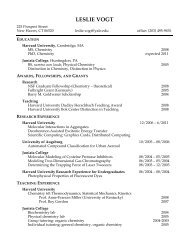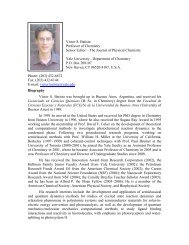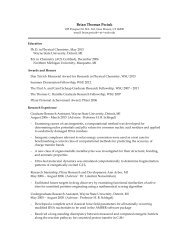Kepler PredictorâCorrector Algorithm - Yale Chemistry - Yale ...
Kepler PredictorâCorrector Algorithm - Yale Chemistry - Yale ...
Kepler PredictorâCorrector Algorithm - Yale Chemistry - Yale ...
You also want an ePaper? Increase the reach of your titles
YUMPU automatically turns print PDFs into web optimized ePapers that Google loves.
ARTICLE<br />
pubs.acs.org/JCTC<br />
<strong>Kepler</strong> Predictor Corrector <strong>Algorithm</strong>: Scattering Dynamics<br />
with One-Over-R Singular Potentials<br />
Andreas Markmann,* ,† Frank Graziani, ‡ and Victor S. Batista* ,†<br />
† Department of <strong>Chemistry</strong>, <strong>Yale</strong> University, P.O. Box 208107, New Haven, Connecticut 06520-8107, United States<br />
‡ Center for Applied Scientific Computing and B-Division, Lawrence Livermore National Laboratory, P.O. Box 808,<br />
Livermore, California, United States<br />
ABSTRACT: An accurate and efficient algorithm for dynamics simulations of particles with attractive 1/r singular potentials is<br />
introduced. The method is applied to semiclassical dynamics simulations of electron proton scattering processes in the Wignertransform<br />
time-dependent picture, showing excellent agreement with full quantum dynamics calculations. Rather than avoiding the<br />
singularity problem by using a pseudopotential, the algorithm predicts the outcome of close-encounter two-body collisions for the<br />
true 1/r potential by solving the <strong>Kepler</strong> problem analytically and corrects the trajectory for multiscattering with other particles in the<br />
system by using standard numerical techniques (e.g., velocity Verlet, or Gear Predictor corrector algorithms). The resulting<br />
integration is time-reversal symmetric and can be applied to the general multibody dynamics problem featuring close encounters as<br />
occur in electron ion scattering events, in particle antiparticle dynamics, as well as in classical simulations of charged interstellar<br />
gas dynamics and gravitational celestial mechanics.<br />
1. INTRODUCTION<br />
Understanding the dynamics of particles mutually attracted by<br />
1/r singular potentials is a problem common to a wide range of<br />
systems in chemistry, biology, physics, and astronomy, including<br />
classical and semiclassical studies of electron transfer, 1 excess<br />
electrons in liquids, 2,3 ionic states, 4 electron scattering and<br />
trapping in ionic liquids or solids, 5 7 attractive plasmas with<br />
nuclei and electrons, 8,9 particle antiparticle dynamics, 10 dynamics<br />
of charged interstellar gas particles, 11 and celestial<br />
mechanics. 12,13 However, serious numerical problems typically<br />
arise in classical and semiclassical simulations when particles<br />
gravitate into each other and the potential gradients (or accelerations)<br />
diverge. To avoid this type of Coulomb (or gravitational)<br />
catastrophe problem, simulation studies often rely on<br />
pseudopotentials where the essential singularities of the potentials<br />
are artificially removed. Such approximations lead to integration<br />
methods that are both practical and useful for simulations<br />
of scattering events with large impact parameters, as typically<br />
observed in low-energy collisions of particles with repulsive<br />
cores. However, close-encounter collisions are beyond the<br />
capabilities of pseudopotential methods, and more rigorous<br />
methodologies have to be employed. This paper introduces<br />
a predictor corrector algorithm for dynamics simulations of<br />
particles evolving on attractive 1/r singular potentials. The<br />
method is rigorous and efficient, even when modeling closeencounter<br />
collisions. Its application to semiclassical dynamics<br />
simulations of electron proton scattering in the Wignertransform<br />
time-dependent picture shows excellent agreement<br />
with full quantum dynamics calculations.<br />
The Coulomb catastrophe problem could be avoided by using<br />
a quantum treatment of the attractive interaction, setting a lower<br />
limit for the bound state in the potential. However, quantum<br />
dynamics methods are computationally demanding and scale<br />
poorly (i.e., exponentially) with the number of strongly coupled<br />
particles in the system. For example, quantum dynamics simulations<br />
of dense proton plasmas with electrons are usually computationally<br />
impractical. Accurate simulations of such systems thus<br />
require a rigorous solution to the Coulomb catastrophe problem<br />
within the framework of linear scaling particle simulation techniques,<br />
analogous to standard molecular dynamics simulations.<br />
When implemented with adaptive time-step integrators, such<br />
methods are capable of accurately simulating point particles<br />
interacting through singular attractive pair potentials, bypassing<br />
energy conservation problems associated with divergent<br />
accelerations.<br />
Adaptive time-step integrators are the most common techniques<br />
applied to ensure energy conservation for systems with<br />
rapidly changing potential gradients (or accelerations). However,<br />
such methods are hopeless for simulations of close encounters<br />
since the integration time-steps converge to zero as the accelerations<br />
diverge and bring the simulation to a halt. [Specifically,<br />
the time step becomes so small that additive terms that include<br />
the time step as a factor become smaller than the least significant<br />
digit of the coordinate, so coordinates no longer evolve.]<br />
This happens even if individual time-steps are used for each<br />
particle. 12,14 Conversely, imposing a minimal time-step yields<br />
trajectories that eventually violate energy conservation, prompting<br />
the common practice of using pseudopotentials to artificially<br />
remove the singularities and ensure energy conservation.<br />
Smoothed (pseudo)potentials with a finite value at the origin<br />
have been postulated for electron dynamics 5,8 as well as for ion<br />
dynamics 15 and astrophysical simulations. 12,16 The Coulomb<br />
potential is also commonly switched-off at small interparticle<br />
distances through the use of switching functions (e.g., the error<br />
function). 7,9 These cases are typically distinguished from the<br />
Received: June 29, 2011<br />
Published: November 08, 2011<br />
r 2011 American Chemical Society 24 dx.doi.org/10.1021/ct200452h | J. Chem. Theory Comput. 2012, 8, 24–35
Journal of Chemical Theory and Computation<br />
construction of pseudopotentials based on physical insights, such<br />
as the screening effect of electrons in the conduction band of<br />
metals. 6 In ionic solids (e.g., alkali halides, oxide insulators, or<br />
semiconductors), however, there are no electrons in the conduction<br />
band that could offer screening of Coulombic interactions.<br />
Therefore, alternative methods are required.<br />
Changes in the potential usually alter the underlying dynamics<br />
of the systems yielding artificial effects that disappear only when<br />
the pseudopotentials become more and more similar to the true<br />
potentials. In that limit, however, the numerical problems due to<br />
large gradients usually reappear. An approach that avoids changing<br />
the singular potential has been developed for gravitational<br />
systems, implementing a change of variables that regularizes the<br />
dynamics (e.g., the Kustaanheimo Stiefel (KS) regularization<br />
and related methods 12,17 21 ) and applies standard numerical<br />
integration for the new variables rather than for the original<br />
coordinates. This requires transformation of the time variable<br />
and coordinates that depend on the interparticle distance for the<br />
pair of particles experiencing a close encounter. Great care must<br />
be taken to keep track of transformations for multiple close<br />
encounters and to match up time-steps so that the interaction<br />
with other particles present in the simulation is properly<br />
accounted for, while not sacrificing efficiency. 20,21 As a consequence<br />
of these complications, the method is, to our knowledge,<br />
implemented in only a few stellar codes. 22<br />
In this paper, we introduce a simple <strong>Kepler</strong> predictor corrector<br />
(KPC) algorithm where close-encounter collisions are integrated<br />
analytically by solving the <strong>Kepler</strong> two-body problem without<br />
altering (or smoothing) the Coulomb potential and updating<br />
coordinates based on the residual potential due to particles not<br />
participating in the close encounter. A simple well-known example<br />
for such an approach is the lightly damped harmonic<br />
oscillator, where the frequency of the resulting oscillation is<br />
approximately the same as that of the underlying undamped<br />
oscillator and only the amplitude may be viewed as modulated. 23<br />
In molecular dynamics, the analytic solution of the harmonic<br />
oscillator has been employed by splitting linear molecule<br />
Hamiltonians into a harmonic and anharmonic part and treating<br />
high frequency components of the molecular vibrations analytically,<br />
while treating low frequency components numerically.<br />
24 29<br />
In biological systems, a large speedup was achieved by treating water<br />
molecules as rigid and using analytic solutions for their motion. 30<br />
For the 1/r problem, an update scheme based on a single momentum<br />
shift has been proposed previously for the purpose of<br />
simulating ion collisions. 31 We propose a method that corrects the<br />
predicted scattering trajectories with an additional term rigorously<br />
derived from numerical integrators (e.g., velocity Verlet or<br />
Gear Predictor Corrector algorithms), accounting for the regular<br />
influence of other particles (or external fields) in the system. The<br />
integration method as a whole is time-reversal symmetric, does<br />
not require any time-variable transformation, and can be applied<br />
to the general multibody dynamics problem with close encounters,<br />
as in electron proton scattering processes, particle<br />
antiparticle dynamics, and charged gas dynamics. <strong>Algorithm</strong>ically,<br />
the complete potential is separated into two parts, including<br />
an integrable two-body term that is dominant at close encounters<br />
and a correction due to interactions with all other particles<br />
(or potentials) in the system. With an integrable two-body<br />
problem (as is the case of Coulombic 1/r or van der Waals<br />
1/r 6 potentials), 32 the analytic solution of close encounters is<br />
employed, and the effect due to interactions with all other<br />
particles is introduced by augmenting the analytic solution with<br />
ARTICLE<br />
Figure 1. KPC trajectory (red line) of a particle scattered by a<br />
singularity V s (r), obtained by solving the <strong>Kepler</strong> problem (dashed line),<br />
taking into account the effect of a weakly varying residual potential V r (r)<br />
(bold green lines) as described in the text.<br />
additional terms that stem from the numerical integrator (e.g.,<br />
the velocity Verlet method 33,34 ). The resulting KPC method<br />
allows for integration time-steps on the same order as used for<br />
regular potentials and hence reduces the numerical effort for<br />
problems with close encounters. It is applicable for any integrable<br />
singular pair potential, 32 including the family of integrable<br />
spherically symmetric singular pair potentials that are the focus<br />
of this paper.<br />
The paper is organized as follows. Section 2 introduces the<br />
KPC method as applied to modeling the dynamics of a particle<br />
evolving on a potential with multiple singularities and its generalization<br />
to multibody dynamics. Section 3 describes its implementation<br />
for semiclassical simulations of electron proton<br />
scattering in the Wigner-transform time-dependent picture.<br />
Section 4 presents concluding remarks in perspective of the KPC<br />
limitations and applicability as a general method.<br />
2. KEPLER PREDICTOR CORRECTOR ALGORITHM<br />
2.1. Single Particle Colliding with Multiple Singularities.<br />
Consider the general case of a single particle moving in a<br />
stationary potential with multiple singularities, as shown in<br />
Figure 1. The total potential V acting on the particle is composed<br />
of the spherically symmetric potential V s with the singularity<br />
nearest to the particle, and the residual potential V r :<br />
VðxÞ ¼V s ðrÞ þV r ðxÞ<br />
As an example, we consider the semiclassical trajectory of a fast<br />
electron undergoing multiple scattering through proton plasma,<br />
under the Born Oppenheimer approximation, where V(x) is<br />
defined as the Coulomb potential due to the closest proton V s (x)<br />
plus the sum of Coulomb potentials V r (x) due to the other<br />
protons in the plasma.<br />
During a close encounter with the singularity V s (r), the<br />
electron scattering force is dominated by this closest proton, and<br />
accurate numerical integration faces several difficulties, including<br />
the following:<br />
1. the large absolute value of potential energy,<br />
2. the very large norm of the potential gradient and higher<br />
derivatives, and hence,<br />
3. the very large acceleration of particles and curvature of<br />
trajectories,<br />
4. the requirement of very small time-steps of standard integrators<br />
(such as the Verlet methods and the Nordsieck Gear<br />
Predictor Corrector methods 33,34 ).<br />
ð1Þ<br />
25 dx.doi.org/10.1021/ct200452h |J. Chem. Theory Comput. 2012, 8, 24–35
Journal of Chemical Theory and Computation<br />
The KPC algorithm addresses these challenges by first<br />
predicting the coordinates and momenta due to the collision<br />
with the closest singularity V s (r) and then correcting the resulting<br />
coordinates and momenta according the residual term,<br />
as follows.<br />
Formally, x(t) and p(t) are obtained according to the velocity<br />
33 35<br />
Verlet method:<br />
xðt þ ΔtÞ ¼xðtÞ þ Δt<br />
m pðtÞ Δt 2<br />
2m ∇Vj xðtÞ<br />
ð2Þ<br />
Δt<br />
pðt þ ΔtÞ ¼pðtÞ<br />
2 ð∇Vj xðtÞ þ ∇Vj xðtþΔtÞ Þ ð3Þ<br />
where m = m e is the mass of the particle, and the time increment<br />
Δt is assumed to be sufficiently short to ensure energy conservation.<br />
However, to address the numerical challenge of the close<br />
encounter, we decompose the total force 3V into the contribution<br />
due to the nearest singularity 3V s and the contributions due<br />
to smaller residual forces 3V r and write suggestively:<br />
xðt þ ΔtÞ ¼xðtÞ þ Δt<br />
m pðtÞ Δt 2<br />
2m ð∇V s j xðtÞ þ ∇V r j xðtÞ Þ<br />
pðt þ ΔtÞ ¼pðtÞ<br />
Δt<br />
2 ð∇V r j xðtÞ þ ∇V s j xðtÞ<br />
þ ∇V s j xðtþΔtÞ þ ∇V r j xðtþΔtÞ Þ<br />
and introducing auxiliary coordinates<br />
x r ðtÞ ¼xðtÞ<br />
p r ðtÞ ¼pðtÞ<br />
ð4Þ<br />
ð5Þ<br />
ð6Þ<br />
Δt<br />
2 ∇V r j xðtÞ ð7Þ<br />
x s ðt þ ΔtÞ ¼x r ðtÞ þ Δt<br />
m pr ðtÞ<br />
Δt 2<br />
2m ∇V s j xr ðtÞ<br />
¼ xðtÞ þ Δt<br />
m pðtÞ Δt 2<br />
2m ð∇V s j xðtÞ þ ∇V r j xðtÞ Þ<br />
ð8Þ<br />
ð9Þ<br />
p s ðt þ ΔtÞ ¼p r Δt<br />
ðtÞ<br />
2 ð∇V s j xr ðtÞ þ ∇V s j xs ðtþΔtÞ Þ ð10Þ<br />
We obtain by comparison with eqs 4 and 5:<br />
xðt þ ΔtÞ ¼x s ðt þ ΔtÞ<br />
ð11Þ<br />
pðt þ ΔtÞ ¼p s Δt<br />
ðt þ ΔtÞ<br />
2 ∇V r j xðtþΔtÞ ð12Þ<br />
The auxiliary variables were constructed such that eqs 8 and 10<br />
become velocity Verlet equations for only the singular potential<br />
V s (r), so they provide a practical way of predicting coordinates<br />
and momenta at time t + Δt, as solely determined by the twobody<br />
collision with the closest proton. During a close encounter,<br />
however, such equations become numerically stiff, and they are<br />
replaced by analytic solutions of the corresponding two-body<br />
<strong>Kepler</strong> initial value problem with initial coordinates (x r (t),p r (t))<br />
ARTICLE<br />
[three-body collisions are usually prevented by Coulombic<br />
repulsion under cool plasma conditions] as described in section<br />
2.3. [The two-body problem is integrable for a variety of<br />
spherically symmetric interaction potentials, including the Coulomb<br />
r 1 potential and van der Waals r 6 type potentials. 32 In<br />
particular, the two-body problem for the 1/r potential is known<br />
as the “<strong>Kepler</strong> problem,” since the elliptical trajectories obey<br />
<strong>Kepler</strong>’s laws of planetary motion.] Having obtained x s (t + Δt)<br />
and p s (t + Δt), we obtain x(t + Δt) and p(t + Δt) by correcting<br />
the predicted coordinates and momenta according to eq 12. It<br />
turns out that x r (t) and x s (t + Δt) are not, as indicated in Figure 1,<br />
distinct from x(t) and x(t + Δt), but their corresponding<br />
momenta are.<br />
The resulting KPC algorithm thus allows for the integration of<br />
close-encounter collisions beyond the capabilities of the standard<br />
velocity Verlet algorithm (i.e., eqs 4 and 5), as follows:<br />
A. Determine p r (t) by a momentum shift according to eq 6.<br />
B. Obtain (x s (t + Δt), p s (t + Δt)) by solving the two-body<br />
<strong>Kepler</strong> problem. The analytic solution S K is a set that<br />
contains position, momentum, and, in principle, all higher<br />
derivatives of the position at the final time t + Δt:<br />
ðx s ðt þ ΔtÞ, p s ðt þ ΔtÞÞ ⊂ S K ðx r ðtÞ, p r ðtÞÞ<br />
ð13Þ<br />
C. From p s (t + Δt), determine p(t + Δt) according to eq 12.<br />
Maximum efficiency is achieved when the analytic task is<br />
restricted to small regions surrounding the singularity closest to<br />
the scattering particle, since the solution of the <strong>Kepler</strong> problem is<br />
more involved than a velocity Verlet integration step. This is<br />
typically ensured by defining a cutoff distance r min from the<br />
singularity center, below which the KPC method is implemented.<br />
In the case under consideration, the potential is stationary, and<br />
the cutoff distance can be set to a constant value much smaller<br />
than half the minimal distance between singularities, r min , 1/2<br />
min{r ij }. It should be small enough that the residual potential<br />
V r is always much more slowly varying than the close-encounter<br />
potential V s , guaranteeing that the singular potential dominates<br />
the dynamics and the influence of the residual potential leads<br />
only to small corrections. To make the method fully time-reversal<br />
symmetric, the cutoff criterion has to be made time-reversal<br />
symmetric as well, in the following way. The KPC method is used<br />
when the initial coordinate is inside the cutoff radius from a<br />
scattering center. If the coordinate after the time step is outside<br />
the cutoff radius, the result is discarded, and a velocity Verlet step<br />
is made instead.<br />
In contrast to ref 31 where a single momentum shift was<br />
applied, our symmetrized approach uses two momentum shifts<br />
per time step. However, the potential gradient needs only be<br />
evaluated once per time step.<br />
2.2. Multibody Molecular Dynamics. The generalization of<br />
the KPC algorithm, introduced in section 2.1, to multibody molecular<br />
dynamics is straightforward. Let (x(t), ξ(t)) and (p(t), π(t))<br />
be the position and momentum vectors of the system at time t.<br />
Without a loss of generality, let (x(t), p(t)) be the six-dimensional<br />
phase-space vector describing the relative motion of two particles<br />
undergoing a close encounter and m be their reduced mass, while<br />
their center-of-mass coordinate, along with the coordinates of all<br />
other particles (some of which may also be in a close encounter), is<br />
contained in the phase-space vector (ξ(t), π(t)).<br />
While the interparticle potential V(x(t), ξ(t)) includes all of<br />
the interactions, only the dynamics of the relative coordinate<br />
26 dx.doi.org/10.1021/ct200452h |J. Chem. Theory Comput. 2012, 8, 24–35
Journal of Chemical Theory and Computation<br />
(x(t), p(t)) are discussed in the following. Accordingly, the<br />
gradient will denote the vector of partial derivatives with respect<br />
to the relative coordinate x only:<br />
<br />
∇ 3 V ¼<br />
∂V , :::, ∂V<br />
∂x 1 ∂x 3<br />
<br />
ð14Þ<br />
The dependence of the phase-space relative coordinates<br />
(x(Δt), p(Δt)) on initial conditions (x(0), p(0)) is then<br />
approximated by<br />
xðt þ ΔtÞ ¼xðtÞ þ Δt<br />
m pðtÞ Δt 2<br />
2m ∇ 3Vj ðxðtÞ, ξðtÞÞ ð15Þ<br />
pðt þ ΔtÞ ¼pðtÞ<br />
Δt<br />
2 ð∇ 3Vj ðxðtÞ, ξðtÞÞ<br />
þ ∇ 3 Vj ðxðtþΔtÞ, ξðtþΔtÞÞ Þ<br />
ð16Þ<br />
To deal with the close encounter, the potential V is again<br />
written as a sum of the close encounter potential V s (r), r =||x||,<br />
and the residual potential V r (x, ξ):<br />
Vðx, ξÞ ¼V s ðrÞ þV r ðx, ξÞ<br />
ð17Þ<br />
and eqs 15 and 16 become<br />
xðt þ ΔtÞ ¼xðtÞ<br />
pðt þ ΔtÞ ¼pðtÞ<br />
þ Δt<br />
m pðtÞ Δt 2<br />
2m ð∇ 3V s j xðtÞ<br />
þ ∇ 3 V r j ðxðtÞ, ξðtÞÞ Þ<br />
Δt<br />
2 ð∇ 3V r j ðxðtÞ, ξðtÞÞ<br />
þ ∇ 3 V s j xðtÞ þ ∇ 3 V s j xðtþΔtÞ<br />
þ ∇ 3 V r j ðxðtþΔtÞ, ξðtþΔtÞÞ Þ<br />
ð18Þ<br />
ð19Þ<br />
Following section 2.1, we define appropriate auxiliary coordinates<br />
and momenta:<br />
x r ðt þ ΔtÞ ¼xðtÞ<br />
ð20Þ<br />
p r ðt þ ΔtÞ ¼pðtÞ<br />
x s ðt þ ΔtÞ ¼x r ðtÞ þ Δt<br />
m pr ðtÞ<br />
p s ðt þ ΔtÞ ¼p r ðtÞ<br />
and we obtain<br />
xðt þ ΔtÞ ¼x s ðt þ ΔtÞ<br />
Δt<br />
2 ∇ 3V r j ðxðtÞ, ξðtÞÞ ð21Þ<br />
Δt 2<br />
2m ∇ 3V s j x r ðtÞ<br />
ð22Þ<br />
Δt<br />
2 ð∇ 3V s j x r ðtÞ þ ∇ 3V s j x s ðtþΔtÞ Þ ð23Þ<br />
ð24Þ<br />
pðt þ ΔtÞ ¼p s Δt<br />
ðt þ ΔtÞ<br />
2 ∇ 3V r j ðxðtþΔtÞ, ξðtþΔtÞÞ ð25Þ<br />
During a close encounter, eqs 22 and 23 are replaced by the<br />
analytic solution of the <strong>Kepler</strong> problem, as described in section<br />
2.3, and the resulting values are then augmented according to<br />
ARTICLE<br />
eqs 24 and 25. The resulting algorithm for multibody molecular<br />
dynamics is summarized, as follows:<br />
1. Determine p r (t) by momentum shift according to eq 21.<br />
2. Compute (x s (t + Δt), p s (t + Δt)) by solving the <strong>Kepler</strong><br />
problem S K :<br />
ðx s ðt þ ΔtÞ, p s ðt þ ΔtÞÞ ⊂ S K ðxðtÞ, pðtÞÞ<br />
ð26Þ<br />
3. Obtain coordinates x(t + Δt) and ξ(t + Δt), as follows:<br />
a. From x s (t + Δt), determine x(t + Δt) according to eq 24.<br />
b. Obtain ξ(t + Δt) by using velocity Verlet, or otherwise<br />
solving steps 2 and 3a for relative coordinates describing<br />
two-body close encounters.<br />
4. Obtain momenta p(t + Δt) and p(t + Δt), as follows:<br />
a. From p s (t + Δt), determine p(t + Δt) according to eq 25.<br />
b. Determine π (t + Δt), analogously to step 3b.<br />
2.3. <strong>Kepler</strong> Problem. When a close encounter is detected, we<br />
consider the particle attracted by the nearest singularity:<br />
V s γ<br />
ðrÞ ¼<br />
ð27Þ<br />
r<br />
where<br />
rðtÞ ¼x s ðtÞ X ð28Þ<br />
with X being the position of the singularity. We solve the<br />
equation of motion:<br />
€r þ μ r<br />
r 3 ¼ 0<br />
ð29Þ<br />
with force parameter μ = γ/m resulting from the gravitational or<br />
Coulomb coefficient γ and the mass m, and initial conditions r 0 =<br />
x(t) X and v 0 = _x(t). The solutions exploit the conservation of<br />
specific angular momentum L = r v, specific energy h s (t) =<br />
v 2 /2 μ/r, and eccentricity vector e = v (r v)/μ r/r.<br />
Equation 29 is regularized by introducing the fictitious time<br />
τ with<br />
d<br />
dτ ¼ r d ð30Þ<br />
dt<br />
leading to the regularized equation of motion<br />
r 00 2h s r ¼ μe ð31Þ<br />
where the derivatives in eq 31 are in respect to τ, and the initial<br />
conditions are modified according to eq 30 to r(τ =0)=r 0 and<br />
r 0 (τ =0)=rv 0 . This is a harmonic oscillator problem that is<br />
readily solved by exponential functions, typically leading to real<br />
solutions that are trigonometric or hyperbolic functions.<br />
The motion is characterized according to four classes of<br />
possible solutions, including circular, parabolic, elliptic, and<br />
hyperbolic, as shown in the following subsections. 36 [In<br />
contrast, ref 36 considers 13 classes of solutions, including<br />
the circular case and 12 other cases generated from the<br />
elliptic, hyperbolic, and parabolic classes as subdivided according<br />
to the values of the rotational momentum and<br />
fictitious time τ, described below.] The circular and parabolic<br />
cases have simple, explicit solutions, while the elliptic and<br />
hyperbolic cases lead to <strong>Kepler</strong> equations that need to be<br />
solved iteratively. 37,38<br />
2.3.1. Circular Motion. When r 0 3 v 0 = 0, the eccentricity e =0<br />
and eq 31 becomes homogeneous. In this case, r 0 3 v 0 = 0 and<br />
v 0 =(μ/r 0 ) 1/2 ; i.e., the coordinate change is orthogonal to the<br />
27 dx.doi.org/10.1021/ct200452h |J. Chem. Theory Comput. 2012, 8, 24–35
Journal of Chemical Theory and Computation<br />
radius vector, so that particle motion is circular and<br />
rðt þ ΔtÞ ¼c r r 0 þ c v<br />
v 0<br />
n<br />
ð32Þ<br />
vðt þ ΔtÞ ¼ nc v r 0 þ c r v 0 ð33Þ<br />
where c v = sin(n(t + Δt)) and c r = cos(n(t + Δt)), with n = j 3 /μ<br />
and j = (2|E s (t + Δt)|/m) 1/2 .<br />
2.3.2. Parabolic Motion. When e = 1, the specific energy h s =0,<br />
and eq 31 has no linear term, giving the parabolic solution<br />
rðt þ ΔtÞ ¼ 1 2 ðp<br />
μ½τðt þ ΔtÞŠ2 Þe þ τðt þ ΔtÞB<br />
rðt þ ΔtÞ ¼ 1 2 ðp þ μ½τðt þ ΔtÞŠ2 Þ<br />
ð34Þ<br />
ð35Þ<br />
1<br />
vðt þ ΔtÞ ¼ ð μ½τðt þ ΔtÞŠe þ BÞ ð36Þ<br />
rðt þ ΔtÞ<br />
where B = L e. The fictitious time τ(t), introduced above, is<br />
obtained by solving the <strong>Kepler</strong> equation:<br />
t t P ¼ 1 <br />
<br />
2 pτðtÞ þμ 3 ½τðtÞŠ3<br />
ð37Þ<br />
where t P is the pericenter time:<br />
<br />
t P ¼ τ 0 p þ μ <br />
3 τ2 0<br />
p is the semilatus rectum:<br />
p ¼ L2<br />
μ<br />
and τ 0 is the fictitious time at time t:<br />
ð38Þ<br />
ð39Þ<br />
τ 0 ¼ r 0 3 v 0<br />
ð40Þ<br />
μ<br />
Equation 37 can be solved explicitly to obtain the fictitious<br />
time, as follows:<br />
qffiffiffiffiffiffiffiffiffiffiffiffiffiffiffiffiffiffiffi<br />
qffiffiffiffiffiffiffiffiffiffiffiffiffiffiffiffiffi<br />
τðtÞ ¼<br />
3p 1 ffiffiffið<br />
t D þ<br />
ffiffiffi<br />
3<br />
p<br />
3<br />
pffiffiffi<br />
D þ t D DÞ<br />
ð41Þ<br />
μ<br />
where negative values are assumed for negative arguments of the<br />
cube root, t D =3(t t P ) and D = t 2 D + p 3 /μ.<br />
2.3.3. Elliptic and Hyperbolic Motion. When e 6¼ 0 and 1, the<br />
motion is either elliptic (e 1,h s > 0).<br />
In either case, we obtain the eccentric anomaly:<br />
εðt þ ΔtÞ ¼jτðt þ ΔtÞ<br />
ð42Þ<br />
as the solution of the (elliptic or hyperbolic) <strong>Kepler</strong> equation at<br />
time t + Δt, as described below. The resulting eccentricity defines<br />
the values of c v and c r (see below) and, therefore, the coordinates<br />
and velocities, as follows:<br />
rðt þ ΔtÞ ¼ 1 k<br />
rðt þ ΔtÞ ¼ 1<br />
<br />
c r<br />
e<br />
ec r<br />
k<br />
<br />
1<br />
e þ c v<br />
ej B<br />
ð43Þ<br />
ð44Þ<br />
vðt þ ΔtÞ ¼<br />
1<br />
erðt þ ΔtÞ<br />
μc v<br />
e þ c r B<br />
j<br />
!<br />
ARTICLE<br />
ð45Þ<br />
where k = 2h s /μ and j = (2|h s |) 1/2 .<br />
When h s (t) < 0, the eccentricity ε is the solution of the<br />
elliptic <strong>Kepler</strong> equation:<br />
nðt þ Δt t P Þ¼εðt þ ΔtÞ e sin½εðt þ ΔtÞŠ ð46Þ<br />
n = j 3 /μ, which can be solved iteratively, as described in section<br />
2.3.4. The resulting ε(t + Δt) gives the trigonometric functions:<br />
c v ¼ sin½εðt þ ΔtÞŠ<br />
ð47Þ<br />
c r ¼ cos½εðt þ ΔtÞŠ<br />
ð48Þ<br />
which determine the coordinates and velocities, according to<br />
eqs 43 and 45.<br />
The pericenter time t P , introduced by eq 46, is obtained from<br />
the eccentricity at the initial time ε 0 , as follows:<br />
ε 0 e sin ε 0<br />
t P ¼<br />
ð49Þ<br />
n<br />
where ε 0 = atan2(y,x), with<br />
y ¼ sin ε 0 ¼<br />
n<br />
kμe r 0 3 v 0<br />
ð50Þ<br />
!<br />
x ¼ cos ε 0 ¼ 1 nr 0<br />
1<br />
e j<br />
ð51Þ<br />
Analogously, when h s (t) > 0, the eccentricity ε(t + Δt) is the<br />
solution of the hyperbolic <strong>Kepler</strong> equation:<br />
nðt þ Δt t P Þ¼ εðt þ ΔtÞ þe sinh εðt þ ΔtÞ<br />
ð52Þ<br />
which is solved iteratively, as described in section 2.3.4, using the<br />
pericenter time:<br />
t P ¼ 1 <br />
n sinh 1 1<br />
e 3 nr 0 3 v 0<br />
μk<br />
<br />
þ nr 0 3 v 0<br />
μk<br />
<br />
ð52aÞ<br />
The resulting eccentricity ε(t + Δt) gives the hyperbolic functions<br />
c v ¼ sinh εðt þ ΔtÞ<br />
ð53Þ<br />
c r ¼ cosh εðt þ ΔtÞ<br />
ð54Þ<br />
that determine the coordinates and velocities, according to eqs<br />
43 and 45.<br />
2.3.4. Iterative Solution of Elliptic and Hyperbolic Equations.<br />
The elliptic and hyperbolic <strong>Kepler</strong> equations, introduced by<br />
eqs 46 and 52, have the general form<br />
nðt þ Δt t P Þ¼M ¼ ( ε - e sinðhÞ ε ð55Þ<br />
When n(t + Δt t P )
Journal of Chemical Theory and Computation<br />
M and e, where each Halley’s iteration is followed by a Newton<br />
Raphson optimization. The iterative scheme typically converges<br />
to machine accuracy in about three iterations. 37 The initial guess<br />
ε (0) a is obtained, as follows:<br />
Elliptic <strong>Kepler</strong> Equation. For elliptic motion (0 e M e π and<br />
0 e e e 1) and small M, we expand the sin function in eq 56 to<br />
third order, and the resulting approximation of M is substituted<br />
in eq 55, giving a cubic approximation of the elliptic <strong>Kepler</strong><br />
equation:<br />
0 ¼ ε 3 00 þ 3qε 00 2r ð58Þ<br />
where q = 2(1 e)/e and r =3M/e. Solving eq 58, we obtain<br />
2r<br />
ε 00 ¼<br />
c 2 v þ q ð59Þ<br />
þðq=wÞ2<br />
where c v =((r 2 + q 3 ) 1/2 + r) 1/3 . On the other hand, for large M,a<br />
good initial guess is<br />
ε 01 ¼ M<br />
Therefore, we define an initial guess that is valid for intermediate<br />
values of M, asanM-weighted average of the small M guess ε 00<br />
and the large M guess ε 01 :<br />
ε ð0Þ<br />
a ¼ 1 π ðM ε 01 þðπ MÞε 00 Þ ð60Þ<br />
¼ 1 π ðM2 þðπ MÞε 00 Þ ð61Þ<br />
Hyperbolic <strong>Kepler</strong> Equation. For hyperbolic motion (M >0<br />
and 1 e e) with small M, the sinh function in eq 56 is expanded to<br />
third order, and the resulting approximation of M is introduced<br />
into eq 55 to give the cubic approximation to the hyperbolic<br />
<strong>Kepler</strong> equation:<br />
0 ¼ ε 3 00 þ 3qε 00 2r ð62Þ<br />
where q =2(e 1)/e and r =3M/e, with the same formal solution<br />
introduced by eq 59, although there are different values of q and r.<br />
Bounded coefficients are obtained through an iterative procedure<br />
based on the hyperbolic equation divided by e, as follows:<br />
0 ¼ M ε þ e sinh½εŠ ð63Þ<br />
0 ¼ L gε þ sinh½εŠ ð64Þ<br />
with L = M/e and g =1/e. For large L, a good initial guess is<br />
ε 01 ¼ sinh 1 L<br />
ð65Þ<br />
which is again mixed with ε 00 , as follows:<br />
ε ð0Þ<br />
a ¼ M ε 01 þ 1 ε 00<br />
M þ 1<br />
¼ M sinh 1 L þ ε 00<br />
M þ 1<br />
3. ELECTRON SCATTERING<br />
ð66Þ<br />
ð67Þ<br />
3.1. Time-Dependent Wigner Transform. This section<br />
illustrates the capabilities of the KPC algorithm, introduced in<br />
section 2, as applied to semiclassical dynamics simulations of<br />
electron proton scattering processes in the Wigner-transform<br />
ARTICLE<br />
time-dependent picture. Simulations consider the problem of<br />
electron scattering from stationary protons, as described within<br />
the Born Oppenheimer approximation (i.e., with m = m e and<br />
the Coulombic parameter γ = 1 au, so that μ = γ/m = 1 au).<br />
The initial state for the scattering electron is defined by the<br />
three-dimensional Gaussian:<br />
!<br />
ψ 0 ðxÞ ¼ð2πσ 2 Þ 3=4 ðx x 0 Þ 2<br />
exp<br />
4σ 2 þ i p p 0 ðx x 0Þ ð68Þ<br />
with average position x 0 and momentum p 0 . The corresponding<br />
Wigner transform: 39<br />
P 0 ðx, pÞ ¼ 1 <br />
Z ∞<br />
ð2πpÞ 3 ∞ ψ 0 x þ s <br />
s<br />
ψ<br />
2 0 x e ip 3 s ds ð69Þ<br />
2<br />
" #<br />
1<br />
¼<br />
ð2πpσ x σ p Þ 3 exp ðx x 0 Þ 2 ðp p 0 Þ 2<br />
2σ 2 x 2σ 2 ð70Þ<br />
p<br />
defines the initial phase-space distribution function, where σ x = σ<br />
and σ p is defined by the uncertainty relation σ x σ p = p/2.<br />
The full quantum-mechanical Wigner distribution P QM t (x,p)is<br />
computed as<br />
<br />
Pt<br />
QM 1<br />
Z ∞<br />
ðx, pÞ ¼<br />
ð2πpÞ 3 ∞ ei=pp 3 s ψ t x þ s <br />
ψ<br />
2 t x<br />
<br />
s<br />
2<br />
ds<br />
ð71Þ<br />
where ψ t is the solution of the time-dependent Schr€odinger<br />
equation<br />
!<br />
ip ∂ ∂t ψ tðxÞ ¼ ^p2 þ VðxÞ<br />
2m e<br />
ψ t ðxÞ<br />
ð72Þ<br />
with<br />
VðxÞ ¼<br />
q j<br />
jx R j j<br />
ð73Þ<br />
∑<br />
j<br />
where the sum is over all protons j, with charge q j =+e, and<br />
coordinates R j . ψ t (x) is represented on a three-dimensional grid<br />
and propagated according to the standard Split Operator Fourier<br />
Transform (SOFT) method. 40,41 The grid is defined as follows:<br />
x αk = x α0 + kΔx, k = 1, 2, ..., 128, where α =1 3 enumerates the<br />
Cartesian directions, x 10 = 4 Å, and x 20 = x 30 = 5 Å. The grid<br />
spacings Δx = 10/128 Å and Δt =10 4 fs define a sufficiently fine<br />
space time grid that ensures an accurate representation of the<br />
oscillatory structure of ψ t (x), even during high-energy collisions<br />
(e.g., collisions with tens of electronvolts). The full-quantum<br />
propagation is based on the short-time Trotter approximation of<br />
the time-evolution operator:<br />
ψ tþΔt ðxÞ ¼Uðt, t þ ΔtÞ ψ t ðxÞ<br />
ð74aÞ<br />
≈ e i=pVΔt=2 e i=p^p2 =2m eΔt e i=pVΔt=2 ψ t ðxÞ<br />
ð74Þ<br />
The time-evolved semiclassical Wigner distribution P SC t (x,p) is<br />
computed as follows:<br />
Z ∞<br />
Pt<br />
SC ðx, pÞ ¼ð2πÞ 3 ds<br />
∞<br />
Z ∞<br />
∞<br />
Z ∞<br />
dp 0 dx 0 e iðp<br />
∞<br />
p t Þs δðx t xÞ P 0 ðx 0 , p 0 Þ<br />
ð75aÞ<br />
¼ 1 N ∑N δðp p t ðjÞÞ δðx t ðjÞ xÞ ð75Þ<br />
j ¼ 1<br />
where x t (j) andp t (j) are coordinates and momenta, obtained by<br />
classical KPC propagation. The initial coordinates and momenta<br />
29 dx.doi.org/10.1021/ct200452h |J. Chem. Theory Comput. 2012, 8, 24–35
Journal of Chemical Theory and Computation<br />
x 0 (j) and p 0 (j) are sampled by Box Muller Monte Carlo, 42<br />
using the phase-space distribution |P 0 (x 0 , p 0 )|.<br />
3.2. Results. Three model systems were analyzed, including<br />
electron scattering from a single central proton (model I),<br />
scattering from a central proton in the presence of a peripheral<br />
proton (model II), and scattering through a cluster of 125<br />
protons in a configuration typical of a high-density plasma<br />
(model III). In models I and II, the initial state for the scattering<br />
electron was defined according to eq 68, with σ 0 = σ = 0.5 Å,<br />
x 0 = 1 au, z 0 = 0, and y 0 = k 0.2 au, where k = 1, 2, ..., 5.<br />
Therefore, the initial momentum of the scattering electron was<br />
defined as follows:<br />
p 2 0<br />
¼ 2m e ÆT 0 æ<br />
¼ 2m e ðE ÆV 0 æÞ<br />
<br />
≈ 2m e E þ 1 ð76Þ<br />
r 0<br />
with r 2 0 = x 2 0 + y 2 0 , and E = 9.2 eV, defining the initial kinetic<br />
energies as listed in Table 1.<br />
Figure 2 shows the comparison of electron proton scattering<br />
trajectories, as described by a single classical trajectory (dots,<br />
with initial coordinates and momenta defined by the expectation<br />
values of the initial state) and the corresponding full-quantum<br />
(SOFT, crosses) and Wigner semiclassical expectation values<br />
(lines).<br />
Table 1. Impact Parameters y 0 and Initial Kinetic Energies<br />
(K.E.) for Trajectories Shown in Figure 2<br />
y 0 (a.u.)<br />
initial K.E. (eV)<br />
0.2 35.9<br />
0.4 34.5<br />
0.6 32.5<br />
0.8 30.4<br />
1.0 28.4<br />
ARTICLE<br />
Figure 2 shows that classical trajectories and benchmark fullquantum<br />
trajectories agree at very early times but quickly deviate<br />
from each other. In contrast, the semiclassical Wigner description<br />
is in almost quantitative agreement with full quantum dynamics<br />
throughout the whole propagation time for all cases investigated,<br />
including model II where scattering trajectories curve away from<br />
the central proton due to the significant influence of the<br />
peripheral scattering center and the nearly symmetric impact of<br />
the central proton on the extended wave packet.<br />
The origin of small deviations, shown in Figure 2, when<br />
comparing the Wigner semiclassical description to the fullquantum<br />
results, can be traced tothecomparisonofthe<br />
distribution functions in configurational space (see Figure 3).<br />
The initial (left) and final (right) densities are shown for impact<br />
parameter 0.4 Å for models I (top) and II (bottom), respectively.<br />
Large dots indicate proton positions, while small dots correspond<br />
to the ensemble distribution. Contours are drawn at<br />
σ, 2σ, and 3σ from the maximum density integrated over the<br />
z coordinate (~60.6%, 13.5%, and 1.1%). SOFT (red) density<br />
distributions are compared to the semiclassical Wigner distributions<br />
(blue), collected in 64 2 quadratic bins covering the<br />
quantum grid (i.e., each bin covers 2 3 quantum grid cells). For<br />
illustration purposes, the ensemble of trajectories shown in<br />
Figure 2 corresponds to a simulation using 5 6 = 15 625 trajectories.<br />
Contour lines and quantitative measures are derived from<br />
simulations using 7 6 = 117 649 trajectories. A maximum allowed<br />
energy change of 2.72 10 2 eV/fs for each trajectory was<br />
enforced at each time step as the basis for the adaptive time step,<br />
with a smallest allowed time step of 10 39 s.<br />
Deviations between SOFT and semiclassical results, shown in<br />
Figure 3, include small components of the semiclassical distributions<br />
that remain bound, localized at the protons. This is<br />
observed even at the final propagation time, although the full<br />
quantum distributions have no bound components. This is an<br />
intrinsic limitation of the semiclassical Wigner transform picture<br />
that becomes even more pronounced for lower energy collisions,<br />
when there are more initial conditions bound in the Coulombic<br />
Figure 2. Electron scattering trajectories obtained by expectation values of SOFT full-quantum (red crosses) propagation Wigner classical dynamics<br />
(WCD, solid blue) and classical propagation of a single trajectory with initial position and momentum as defined by the expectation values of the initial<br />
wave packet (blue dots). Left panel (model I): electron collision with a single proton (black bullet) at the origin. Right panel (model II): collision with<br />
two protons, including a central proton at the origin (black bullet) and a peripheral proton (red bullet) at (0,1) au.<br />
30 dx.doi.org/10.1021/ct200452h |J. Chem. Theory Comput. 2012, 8, 24–35
Journal of Chemical Theory and Computation<br />
ARTICLE<br />
Figure 3. Initial (left) and final (right) densities for impact parameter 0.4 Å for electron scattering in models I (top) and II (bottom), respectively. Large<br />
dots indicate proton positions; small dots are WCD representative configurations. Contours are drawn at percentages of the maximum density<br />
(integrated over the z coordinate) found at σ,2 σ, and 3 σ from the center of the distribution, i.e., 60.65%, 13.5%, and 1.1%. Color key: SOFT (red),<br />
WCD (blue).<br />
well. As a result, the position predicted by the Wigner transform<br />
lags behind the quantum result, faintly visible in Figure 2.<br />
The convex features of the final quantum densities are<br />
reproduced well by the WCD method, while concave features<br />
in the lowest contour level of the quantum density are due to<br />
interference effects and by construction not present in WCD.<br />
Nevertheless, the semiclassical Wigner transform reproduces the<br />
overall features of the quantum distribution. In fact, a quantitative<br />
analysis of the normalized distributions shows >92% overlap<br />
between the semiclassical and quantum distributions for all cases<br />
investigated. Even the time-dependent widths, describing the<br />
anisotropy of the distribution functions, are in good qualitative<br />
agreement with full quantum results.<br />
Figure 4 shows the widths for each of the Cartesian directions<br />
describing the time-dependent anisotropy of the distributions.<br />
Note that both quantum and semiclassical results show more<br />
delocalization along the x direction than in the orthogonal<br />
directions y and z. This is likely due to the head-on collision<br />
causing the wave packet to undergo more significant deformation<br />
in the direction of propagation.<br />
Figure 4 shows that the semiclassical distributions slightly<br />
overestimate the widths since they miss interference effects<br />
leading to partial localization of the quantum wave packet. This<br />
is most prominent in the x direction due to the bound component<br />
of the semiclassical distributions, although the trends and<br />
overall agreement are quite satisfactory. In fact, close inspection<br />
of Figure 3 shows that the semiclassical dynamics reproduce the<br />
full-quantum distributions very well, while featuring bound<br />
components and deviations at the lowest-density contour level.<br />
The concave features in the final quantum density are due to<br />
interference effects, which by construction are not present in<br />
WCD. At electron energies above 1 keV, interference becomes<br />
negligible, and the agreement of WCD with quantum results<br />
becomes excellent. Deviations in the long tails of the distributions,<br />
however, affect the overall widths σ disproportionately.<br />
Analogous results are obtained for the description of electron<br />
scattering through a cluster of protons (model III). Figure 5<br />
shows the semiclassical (blue) and quantum (red) distributions<br />
for a high-energy collision of an electron passing through a<br />
disordered cluster of 125 protons (black dots, shown larger for<br />
protons closer to the z = 0 plane), at the initial (left, t = 0 as) and<br />
final (right, t = 50 as) propagation times. The configuration of<br />
the cluster, 43 contained in a box with dimensions 5 5 5 Å, has<br />
been extracted from a plasma of density F =10 24 cm 3 . The<br />
initial state for the scattering electron is defined with a width<br />
according to a 1s state of a hydrogen atom, and with initial kinetic<br />
energy p 0 2 /2m e = 250 eV.<br />
Numerical Effort. Wall times for production run calculations<br />
on a 2.67 GHz intel Core i7 CPU are shown in Table 2. KPC<br />
calculations (second column) are compared to results obtained<br />
according to the adaptive velocity Verlet method (third column)<br />
for two sets of trajectories. The total simulation time is 50 as (5 <br />
10 17 s). A maximum of 2 20 subdivisions of the default time step<br />
was allowed, after which a trajectory was marked as failed if it did<br />
not satisfy a maximum allowed energy change of 2.72 10 2<br />
eV/fs in one default time step. Trajectories do not fail for the<br />
KPC method, while a complete treatment of the failed trajectories<br />
in the velocity Verlet method require longer times than<br />
given here or are impossible altogether. A larger number of<br />
trajectories with randomized initial conditions means an increase<br />
31 dx.doi.org/10.1021/ct200452h |J. Chem. Theory Comput. 2012, 8, 24–35
Journal of Chemical Theory and Computation<br />
ARTICLE<br />
Figure 4. Time dependence of the widths of the time-dependent distributions, as described by semiclassical and quantum calculations of electron<br />
scattering in model I (left) and model II (right), respectively. Semiclassical Wigner transforms tend to overestimate the widths, since they lack<br />
interference terms responsible for partial localization of the full quantum distributions.<br />
Figure 5. Contour plots of quantum (red) and semiclassical (blue) probability densities, integrated over the z coordinate at the initial (left, t = 0 as) and<br />
final (right, t = 50 as) propagation times, for a high-energy collision of an electron passing through a disordered cluster of 125 protons (black dots, shown<br />
larger for protons closer to the z = 0 plane). Coordinates x and y in Å.<br />
Table 2. Wall Times for Production Run Calculations<br />
(in hours:minutes:seconds) on a 2.67 GHz Intel Core i7<br />
CPU of Adaptive KPC Method with Cutoff (Second Column)<br />
and Adaptive Velocity Verlet Method (Third Column)<br />
for Two Different Numbers of Trajectories for a Total<br />
Simulation Time of 50 as 5 10 17 s<br />
particles<br />
adaptive<br />
KPC<br />
adaptive Verlet<br />
failed KPC<br />
trajectories<br />
failed Verlet<br />
trajectories<br />
15625 17:25 23:00 (+32%) 0 1 (0.0064%)<br />
117649 1:55:04 2:44:33 (+43%) 0 15 (0.013%)<br />
in the probability of close encounters, which is reflected by the<br />
increased ratio between the run times of the two methods and the<br />
increased percentage of failed particles.<br />
The selection of trajectories that fail to conserve energy to<br />
within 2.72 10 2 eV/fs when propagated according to velocity<br />
Verlet are uncontrolled by the user and depend on the dynamics,<br />
so that the statistics of the result are skewed. The number of close<br />
encounters scales with the third root of the number of particles<br />
and linearly with time, making failing trajectories a considerable<br />
problem for larger simulations. The adaptive KPC method with<br />
cutoffs is more efficient and suffers from no such drawback, so<br />
that production runs with 1 million or more trajectories can be<br />
performed routinely.<br />
Numerical Accuracy. All KPC results discussed above were<br />
performed with an adaptive time step, ensuring that energy<br />
conservation is satisfied to a given accuracy. The absence of<br />
failed trajectories for the KPC method shows that, time step for<br />
time step, the KPC method is more accurate than velocity Verlet<br />
and effectively solves the close encounter problem.<br />
To quantify energy conservation, close encounter simulations<br />
at a constant time step of a single particle with a resting proton<br />
were performed, with a peripheral proton at 1 au distance<br />
(model II). Figure 6 shows the energy change of KPC at a<br />
constant time step for hyperbolic (left) and elliptic (right)<br />
character trajectories. KPC results are shown for cutoff radii of<br />
0.3 au (black lines), 0.2 au (dark gray lines), 0.1 au (light gray<br />
lines), and no cutoff, i.e., never using velocity Verlet at any<br />
distance (dashed lines). The difficulty of the close encounter<br />
is expressed by energy nonconservation caused by it. As the<br />
electronic particle approaches the protonic scattering center, the<br />
velocity Verlet energy deviates from its initial value, and when<br />
switching to the KPC method at the cutoff radius, energy is<br />
conserved again before oscillating at the point of closest approach.<br />
The energy then returns to the value before its oscillation,<br />
before traversing the cutoff radius causes a switch back to<br />
velocity Verlet. This demonstrates that, at a given time step, the<br />
KPC method conserves energy much closer to the scattering<br />
center than velocity Verlet.<br />
32 dx.doi.org/10.1021/ct200452h |J. Chem. Theory Comput. 2012, 8, 24–35
Journal of Chemical Theory and Computation<br />
ARTICLE<br />
Figure 6. Energy change of KPC at constant time step for hyperbolic (left) and elliptic (right) character trajectories. KPC results are shown for cutoff<br />
radii of 0.3 au (black lines), 0.2 au (dark gray lines), 0.1 au (light gray lines), and no cutoff, i.e. never using velocity Verlet at any distance (dashed lines). It<br />
can be seen that, approaching the scattering center, the velocity Verlet shows a significant energy deviation, while switching to KPC causes the energy to<br />
level off. Energy nonconservation at the smaller cutoff of 0.1 is due to a break down of the velocity Verlet method already outside the cutoff radius, while<br />
using KPC only leads to well conserved energy.<br />
At large cutoff radii, the energy eventually returns to its initial<br />
value, demonstrating that the time-reversal symmetric construction<br />
of the KPC method solves the close-encounter problem. At<br />
the smaller cutoff radius of 0.1 au, the energies do not quite return<br />
to their initial value which, considering the success at larger cutoffs,<br />
must be ascribed to a break down of the velocity Verlet method<br />
already outside the cutoff radius. Velocity Verlet by itself fails at the<br />
given time steps, as witnessed by macroscopic energy shifts after<br />
the close encounters of 0.30 au (8.3 eV) and 0.55 au (14.9 eV).<br />
Note that a shorter time step is shown for the elliptic case, as that<br />
leads to a smaller distance of closest approach. For smaller time<br />
steps, accuracy is improved, while for larger time steps, the<br />
shortcomings of velocity Verlet become more pronounced.<br />
It is worth mentioning that when adaptive time steps are used,<br />
smaller cutoff values may be more useful since they allow for a<br />
reduction in the numerical effort, which per time step is larger for<br />
the KPC method, as well as making sure that cutoff spheres<br />
between neighboring protons never overlap, which is why<br />
0.1 au has been used for all adaptive time step Wigner density<br />
propagations above. In calculations with many potential wells,<br />
where the integrator effort is neglibile in comparison to that for<br />
evaluation of the potential gradient, a larger cutoff is more useful.<br />
4. DISCUSSION<br />
The KPC method is a highly efficient multipurpose method for<br />
simulations of an important class of dynamical problems featuring<br />
singular potentials. The method is easy to implement and offers an<br />
accurate treatment of dynamical problems in which close encounters<br />
between mutually attractive particles may occur. For comparable<br />
integration time steps, the KPC method is more accurate than<br />
standard integrators, even when the <strong>Kepler</strong> equation is solved to<br />
machine accuracy, since its accuracy is determined by the impact of<br />
the slowly varying residual potential on the trajectory (and its<br />
occasionally sudden changes of direction). A sample program<br />
reproducing the calculations reported in Figure 6 is available<br />
free of charge upon request to the corresponding authors.<br />
The KPC method can be made arbitrarily accurate, as opposed<br />
to standard integrators which typically break at some finite<br />
distance of closest approach when the required time step becomes<br />
so small that the operations involved cannot be computed<br />
at the given machine accuracy. The cost of the KPC method<br />
increases when the distance between singularities decreases,<br />
since the cutoff distance must be reduced to keep it smaller than<br />
half the minimal distance between singularities. As the cutoff is<br />
reduced, the cost of standard propagation methods, applied<br />
outside the cutoff distance, increases.<br />
As presented in this paper, the KPC method is limited to<br />
problems with close encounters of two-body collisions. This is<br />
usually sufficient for most molecular dynamics simulations where<br />
the Coulomb repulsion limits close encounters to pairs of<br />
particles of opposite charge and prevents three- and higher-body<br />
collisions. The method, however, could still be used in applications<br />
to gravitational dynamics where multibody close encounters<br />
are much less common than two-body collisions.<br />
To make the KPC method time-reversal symmetric, it has to<br />
be made sure that the cutoff distance is crossed during the same<br />
default time step in both directions. This is done by observing<br />
whether the cutoff is crossed from the inside to the outside<br />
during the default time step, reverting back to the underlying<br />
numerical integrator if this occurs.<br />
As illustrated for models I III, the KPC method allows for<br />
semiclassical dynamics simulations of phase-space distributions<br />
in very good agreement with quantum dynamics simulations. For<br />
electron scattering from attractive Coulomb potentials, the KPC<br />
approach provides a highly parallelizable approach. The method<br />
can be applied in conjunction with a wide range of standard<br />
integrators, including high-order predictor corrector methods<br />
(such as the Nordsieck Gear method) since the solution S K of<br />
the <strong>Kepler</strong> problem yields also higher time derivatives of the<br />
position that can be correctly augmented, as described by eq 25.<br />
At large times, the sampling of classical trajectories becomes<br />
an issue, as the dispersion predicted by the Wigner trajectories is<br />
limited by the largest momentum among these trajectories. The<br />
predictive power of the Wigner density is also easily seen to be<br />
limited in its spatial resolution by the number of trajectories<br />
employed. In the multiple scattering case, self-interference of the<br />
electron may become significant after many interactions, which is<br />
not represented by the current method. In the cases presented<br />
here, it turns out to play a minor role not significantly altering the<br />
resulting densities, so that the Wigner trajectory method yields<br />
good agreement with SOFT.<br />
As discussed in previous sections, the KPC method has been<br />
implemented and illustrated as applied to modeling single<br />
electron scattering from unscreened Coulombic potentials, using<br />
33 dx.doi.org/10.1021/ct200452h |J. Chem. Theory Comput. 2012, 8, 24–35
Journal of Chemical Theory and Computation<br />
ARTICLE<br />
Table 3. Percentage Deviations of the Debye H€uckel Potential and Its Gradient, Relative to the Unscreened Coulomb Potential,<br />
for Different Values of Debye Screening Distances and Cutoff Radii<br />
r = r Verlet min =10 2 au<br />
r = r Gear min =10 3 au<br />
relative deviation d =5au d =10au d =20au d =5au d =10au d =20au<br />
δV DH (r) 2 10 3 10 3 5 10 4 2 10 4 10 4 5 10 5<br />
δ3V DH (r) 2 10 6 5 10 7 1.25 10 7 2 10 8 5 10 9 1.25 10 9<br />
a cutoff radius r min around the scattering centers chosen to<br />
optimize accuracy and performance. The multielectron scattering<br />
problem becomes rather complicated at low energies due to<br />
electron exchange and correlation. Therefore, the <strong>Kepler</strong> predictor<br />
corrector method is expected to be most useful for<br />
the description of electron scattering processes at high (keV)<br />
energies. In this case, fast electrons may be seen as dressing the<br />
nuclear potential seen by an additional electron in the form of the<br />
Yukawa, or Debye H€uckel, screened-Coulomb potential: 44<br />
V DH ðrÞ ¼ 1 <br />
r exp<br />
<br />
r<br />
d<br />
ð77Þ<br />
where d is the Debye screening distance. Analogous treatments<br />
of KPC can be applied for this and other classes of spherical<br />
potentials, especially those whose two-body initial value problem<br />
is solved analytically.<br />
The Yukawa potential in particular, however, converges to the<br />
Coulomb potential when r f 0. Therefore, for a sufficiently small<br />
r min , the solution of the unscreened <strong>Kepler</strong> problem already gives<br />
a good approximation to close encounters for the Yukawa<br />
potential. The intrinsic error can be minimized by setting r min<br />
to an appropriate value. Table 3 shows how small are the<br />
percentage deviations of the Debye H€uckel potential and its<br />
gradient, when compared to the unscreened Coulomb potential,<br />
for various screening distances d and cutoff radii r min .<br />
The deviations can be approximated by Taylor expansion of<br />
the exponential:<br />
δV DH ðrÞ ¼ V DH ðrÞ V s ðrÞ<br />
V s ≈ r ð78Þ<br />
ðrÞ d<br />
δ∇V DH ðrÞ ¼ j∇V DH ðrÞ ∇V s ðrÞj<br />
j∇V s ≈ 1 <br />
r 2<br />
ð79Þ<br />
ðrÞj 2 d<br />
Through an appropriate choice of r min , any desired accuracy<br />
may be achieved for the KPC method for any given d, with a<br />
corresponding impact on computational performance if small<br />
r min values are chosen. Careful analysis of the numerical effort<br />
shows that with the Verlet method, a cutoff of 10 2 au may be<br />
chosen with only minimal penalty to the efficiency of the KPC<br />
method. Under ignition conditions, proton density is on the<br />
order of 10 26 cm 3 , where the mean distance between protons is<br />
larger than 0.2 au, i.e., much larger than this cutoff. If better<br />
numerical accuracy is required, efficiency may be traded in to<br />
obtain even smaller cutoff distances.<br />
Another class of potentials is the repulsive Coulombic potential<br />
between protons, commonly found in high energy density plasma<br />
simulations where kinetic energies are sufficiently high as to cause<br />
close encounters between protons. As at kiloelectronvolt energies,<br />
electron exchange and correlation play a subordinate role for the<br />
system’sdynamics,thesingleelectronmoleculardynamicsmethods<br />
proposed should be applicable. For such simulations, a<br />
repulsive KPC method can be constructed analogously from<br />
the analytic solution of the repulsive <strong>Kepler</strong> problem. For lower<br />
energies (the warm dense matter regime), alternative methods<br />
taking exchange and correlation into account have to be explored.<br />
5. CONCLUSIONS<br />
We have introduced the KPC algorithm for accurate and<br />
efficient simulations of dynamics of particles with attractive 1/r<br />
singular potentials. When used in its time-reversible form (with a<br />
carefully chosen cutoff radius around singularities), the KPC<br />
method always reduces the numerical effort with respect to<br />
standard integrators and allows for the description of close<br />
encounter collisions. The method is easy to implement and<br />
should be practical for a wide range of applications where<br />
particles gravitate into each other, such as electron proton<br />
interactions and ionic dynamics, as well as applications in other<br />
fields with similar computational challenges such as molecular<br />
dynamics of high-density plasmas and celestial mechanics.<br />
We have shown how to apply the KPC method to model<br />
semiclassical dynamics of electron proton scattering processes<br />
in the Wigner-transform time-dependent picture. The reported<br />
results show excellent agreement with benchmark quantum<br />
dynamics calculations, including models with multiple scattering<br />
centers that defy the capabilities of standard integration<br />
methods. The reported results suggest that the Wigner semiclassical<br />
dynamics is a practical and accurate approach to include quantum<br />
effects in high energy electron proton collisions when simulated<br />
according to the KPC method. The KPC method’s applicability<br />
to other singular potentials featuring close encounters should<br />
provide a useful, easy to implement tool for a wide range of studies,<br />
including electron ion scattering events and particle antiparticle<br />
dynamics, as well as in classical simulations of charged interstellar gas<br />
dynamics and gravitational celestial mechanics, where the latter has<br />
not been able to profit from KS-regularization.<br />
’ AUTHOR INFORMATION<br />
Corresponding Author<br />
*E-mail: andreas.markmann@yale.edu; victor.batista@yale.edu.<br />
Notes<br />
The authors declare no competing financial interest.<br />
’ ACKNOWLEDGMENT<br />
V.S.B. acknowledges supercomputer time from NERSC and<br />
support from Lawrence Livermore National Laboratory, grant<br />
B590847. The NSF grants CHE-0911520 and ECCS-0404191<br />
supported the development of methods for quantum dynamics<br />
simulations. We thank Michael Surh, David Richardson, and Jim<br />
Glosli at Lawrence Livermore National Laboratory and Paul<br />
Grabowski and Michael Murillo at Los Alamos National Laboratory<br />
for valuable comments.<br />
34 dx.doi.org/10.1021/ct200452h |J. Chem. Theory Comput. 2012, 8, 24–35
Journal of Chemical Theory and Computation<br />
’ REFERENCES<br />
(1) Jortner, J.; Bixon, M. Electron Transfer - from Isolated Molecules to<br />
Biomolecules; John Wiley and Sons, Inc.: New York, 1999; pp 1.<br />
(2) Schwartz, B.; Rossky, P. J. Chem. Phys. 1994, 101, 6902–6916.<br />
(3) Turi, L.; Sheu, W.; Rossky, P. Science 2005, 309, 914–917.<br />
(4) Harumiya, K.; Kawata, I.; Kono, H.; Fujimura, Y. J. Chem. Phys.<br />
2000, 113, 8953–8960.<br />
(5) Dunn, T.; Broyles, A. Phys. Rev. 1067, 157, 156–166.<br />
(6) Ashcroft, N. J. Phys. C: Proc. Phys. Soc. 1968, 232–243.<br />
(7) Turi, L.; Borgis, D. J. Chem. Phys. 2002, 117, 6186–6195.<br />
(8) Singh, S.; Kumar, S.; Srivastava, M. J. Phys. B.: Atom. Mol. Phys.<br />
1978, 11, 3061–3066.<br />
(9) Filinov, A. V.; Golubnychiy, V.; Bonitz, M.; Ebeling, W.; Dufty, J.<br />
Phys. Rev. E 2004, 70, 046411.<br />
(10) Kimura, M.; Inokuti, M. Phys. Rev. A 1988, 38, 3801–3803.<br />
(11) Avinash, K.; Eliasson, B.; Shukla, P. Phys. Lett. A 2006, 353,<br />
105–108.<br />
(12) Heggie, D.; Hut, P. The Gravitational Million-Body Problem;<br />
Cambridge University Press: Cambridge, U.K., 2003; p 1.<br />
(13) Chambers, J. E. Mon. Not. R. Astron. Soc. 1999, 304, 793–799.<br />
(14) Heggie, D. Introduction to stellar dynamics and N-body integrators.<br />
http://manybody.org/modest/heggie_split.pdf (accessed Nov.<br />
2011).<br />
(15) Paolini, F.; Cabral, E.; dos Santos, A. 36th EPS Conf. Plasma<br />
Phys. Sofia 2009, 33E, O–4.039.<br />
(16) Hernquist, L.; Hut, P.; Makino, J. Astrophys. J. 1993, 402,<br />
L85–L88.<br />
(17) Kustaanheimo, P.; Stiefel, E. J. Reine Angew. Math. 1965, 218,<br />
204–219.<br />
(18) Vivarelli, M. D. Celest. Mech. Dyn. Astron. 1985, 36, 349–364.<br />
(19) Neutsch, W. Quaternionic regularisation of perturbed <strong>Kepler</strong><br />
motion; Preprint, 1991.<br />
(20) Aarseth, S. Direct methods for N-body simulations. In Multiple<br />
Time Scales; Brackbill, J., Cohen, B., Eds.; Academic Press: New York,<br />
1985; pp 377 418.<br />
(21) Aarseth, S. J. Gravitational N-Body Simulations; Cambridge<br />
University Press: Cambridge, U.K., 2003; Cambridge monographs on<br />
mathematical physics, p 1.<br />
(22) Aarseth, S. N-Body Simulation Software. http://www.ast.cam.ac.<br />
uk/∼sverre/ (accessed Nov. 2011).<br />
(23) Kleppner, D.; Kolenkow, R. J. An Introduction to Mechanics, 1st<br />
ed.; Cambridge University Press: Cambridge, U.K., 2010; pp 414 416.<br />
(24) Tuckerman, M.; Martyna, G.; Berne, B. J. Chem. Phys. 1990,<br />
93, 1287.<br />
(25) Tuckerman, M.; Berne, B.; Martyna, G. J. Chem. Phys. 1992, 97,<br />
1990.<br />
(26) Janezic, D.; Merzel, F. J. Chem. Inf. Comput. Sci. 1995, 35,<br />
321–32.<br />
(27) Janezic, D.; Merzel, F. J. Chem. Inf. Comput. Sci. 1997, 37,<br />
1048–1054.<br />
(28) Janezic, D.; Praprotnik, M. Int. J. Quantum Chem. 2001, 84,<br />
2–12.<br />
(29) Janezic, D.; Praprotnik, M. J. Chem. Inf. Comput. Sci. 2003,<br />
43, 1922–1927.<br />
(30) Miyamoto, S.; Kollman, P. A. J. Comput. Chem. 1992, 13,<br />
952–962.<br />
(31) Zwicknagel, G.; Toepffer, C.; Reinhard, P.-G. Phys. Rep. 1999,<br />
309, 117–208.<br />
(32) Broucke, R. Astrophys. Space Sci. 1980, 72, 33–53.<br />
(33) Allen, M. P.; Tildesley, D. J. Computer Simulation of Liquids;<br />
Oxford Science Publications: Oxford, 1987; p 25.<br />
(34) Vesely, F. J. Computational Physics - An Introduction, 2nd ed.;<br />
Kluwer Academic/Plenum Publishers: New York London, 2001;<br />
p 107.<br />
(35) Swope, W. C.; Andersen, H.; Berens, P. H.; Wilson, K. R.<br />
J. Chem. Phys. 1982, 76, 637–649.<br />
(36) Condurache, D.; Martinusi, V. Meccanica 2007, 42, 465–476.<br />
ARTICLE<br />
(37) Odell, A. W.; Gooding, R. H. Celestial Mechanics 1986,<br />
38, 307–334.<br />
(38) Gooding, R. H.; Odell, A. W. Celestial Mechanics 1988, 44,<br />
267–282.<br />
(39) Wigner, E. Phys. Rev. 1932, 40, 949–759.<br />
(40) Feit, M. D.; J. A. Fleck, J.; Steiger, A. J. Comput. Phys. 1982,<br />
47, 412–433.<br />
(41) Feit, M. D.; J. A. Fleck, J. J. Chem. Phys. 1983, 78, 301.<br />
(42) Box, G.; Muller, M. E. Ann. Math. Stat. 1958, 29, 610–611.<br />
(43) Graziani, F. R.; Batista, V. S.; Benedict, L. X.; Castor, J. I.; Chen,<br />
H.; Chen, S. N.; Fichtl, C. A.; Glosli, J. N.; Grabowski, P. E.; Graf, A. T.;<br />
Hau-Riege, S. P.; Hazi, A. U.; Khairallah, S. A.; Krauss, L.; Langdon, A.<br />
B.; London, R. A.; Markmann, A.; Murillo, M. S.; Richards, D. F.; Scott,<br />
H. A.; Shepherd, R.; Stanton, L. G.; Streitz, F. H.; Surh, M. P.; Weisheit,<br />
J. C.; Whitley, H. D. High Energy Dens. Phys. 2011; DOI: 10.1016/<br />
j.hedp.2011.06.010.<br />
(44) Iafrate, G. J.; Mendelsohn, L. B. Phys. Rev. 1969, 182, 244–258.<br />
35 dx.doi.org/10.1021/ct200452h |J. Chem. Theory Comput. 2012, 8, 24–35


